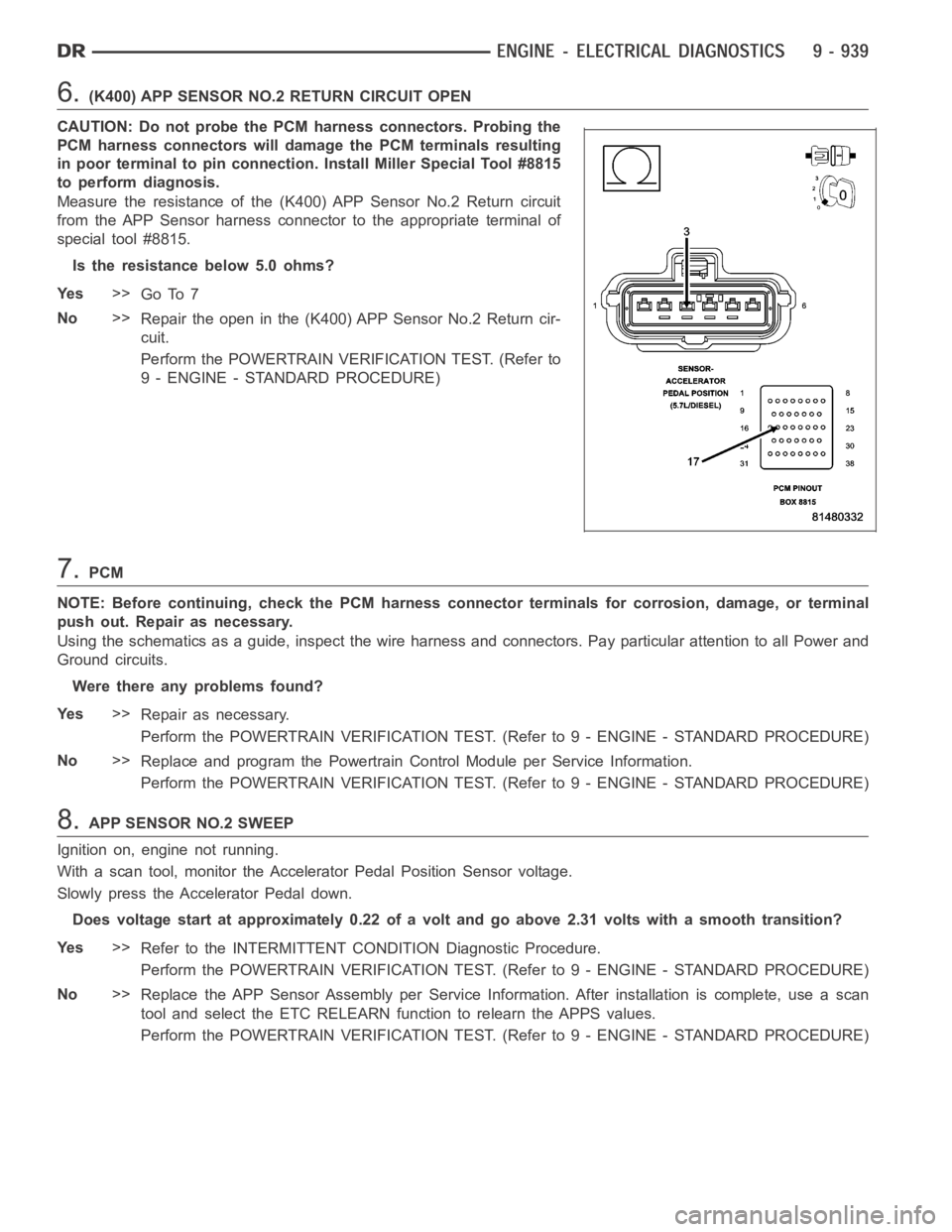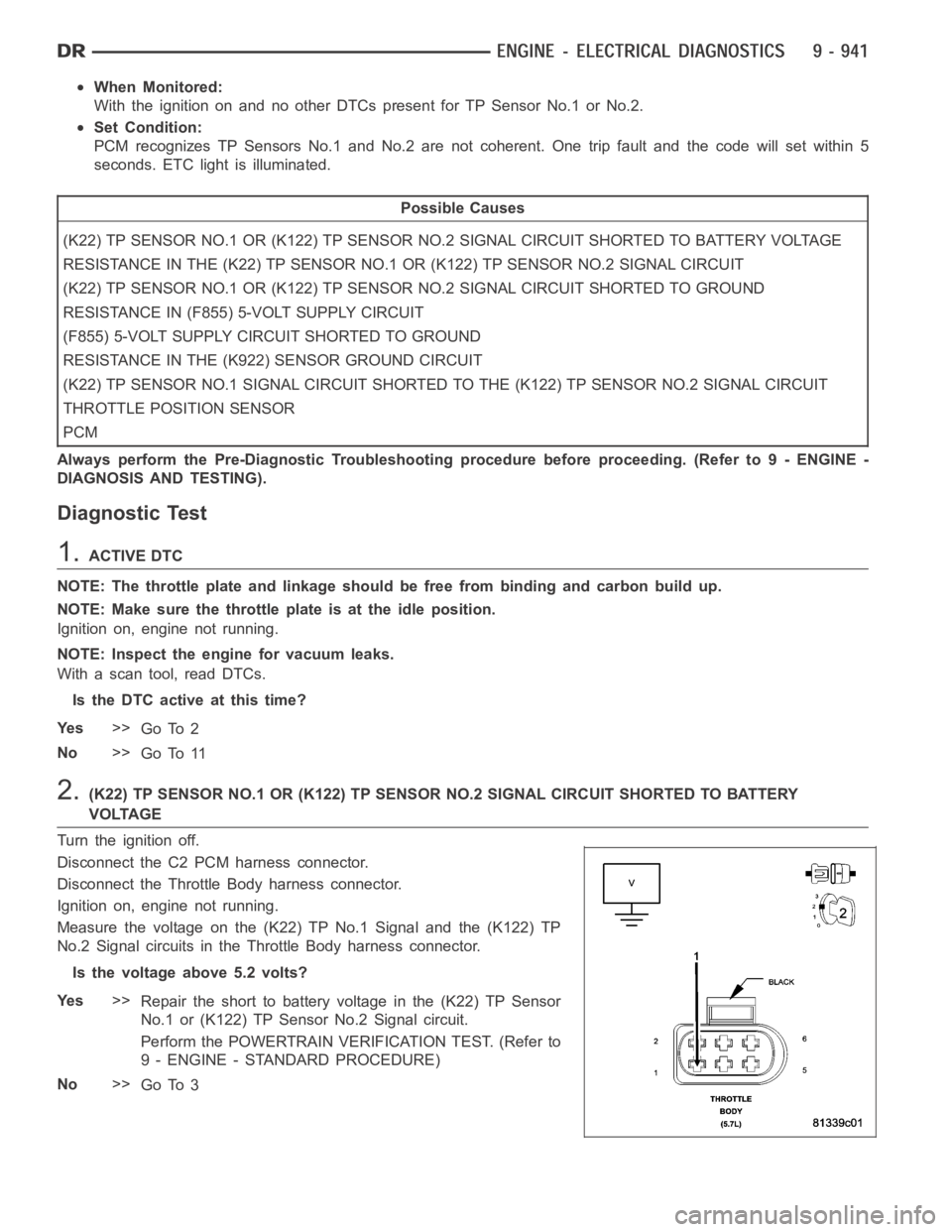Page 243 of 5267

7.(K29) APP SENSOR NO.2 SIGNAL CIRCUIT SHORTED TO THE (K167) APP SENSOR NO.1 RETURN
CIRCUIT
Measure the resistance between the (K29) APP Sensor No.2 Signal cir-
cuit and the (K167) Sensor No.1 Return circuit in the APP Sensor har-
ness connector.
Istheresistancebelow100ohms?
Ye s>>
Repair the short between the (K167) APP Sensor No.1
Return circuit and the (K29) APP Sensor No.2 Signal circuit.
Perform the POWERTRAIN VERIFICATION TEST. (Refer to
9 - ENGINE - STANDARD PROCEDURE)
No>>
Go To 10
8.(F856) 5-VOLT SUPPLY CIRCUIT OPEN
Turn the ignition off.
Disconnect the C1 PCM harness connector.
CAUTION: Do not probe the PCM harness connectors. Probing the
PCM harness connectors will damage the PCM terminals resulting
in poor terminal to pin connection. Install Miller Special Tool #8815
to perform diagnosis.
Measure the resistance of the (F856) 5-volt Supply circuit from the Sen-
sor harness connector to the appropriate terminal of special tool #8815.
Is the resistance below 5.0 ohms?
Ye s>>
Go To 9
No>>
Repair the open in the (F856) 5-volt Supply circuit.
Perform the POWERTRAIN VERIFICATION TEST. (Refer to
9 - ENGINE - STANDARD PROCEDURE)
Page 244 of 5267

9.(F856) 5-VOLT SUPPLY CIRCUIT SHORTED TO GROUND
Measure the resistance between ground and the (F856) 5-volt Supply
circuit in the APP Sensor harness connector.
Istheresistancebelow100ohms?
Ye s>>
Repair the short to ground in the (F856) 5-volt Supply cir-
cuit.
Perform the POWERTRAIN VERIFICATION TEST. (Refer to
9 - ENGINE - STANDARD PROCEDURE)
No>>
Go To 10
10.PCM
NOTE: Before continuing, check the PCM harness connector terminals for corrosion, damage, or terminal
push out. Repair as necessary.
Using the schematics as a guide, inspect the wire harness and connectors. Pay particular attention to all Power and
Ground circuits.
Were there any problems found?
Ye s>>
Repair as necessary.
Perform the POWERTRAIN VERIFICATION TEST. (Refer to 9 - ENGINE - STANDARD PROCEDURE)
No>>
Replace and program the Powertrain Control Module per Service Information.
Perform the POWERTRAIN VERIFICATION TEST. (Refer to 9 - ENGINE - STANDARD PROCEDURE)
11 .APP SENSOR SWEEP
Ignition on, engine not running.
With a scan tool, monitor the APP Sensor No.2 voltage.
Slowly press the Accelerator pedal down.
Does voltage start at approximately 0.22 of a volt and go above 2.31 volts with a smooth transition?
Ye s>>
Refer to the INTERMITTENT CONDITION Diagnostic Procedure.
Perform the POWERTRAIN VERIFICATION TEST. (Refer to 9 - ENGINE - STANDARD PROCEDURE)
No>>
Replace the APP Sensor Assembly per Service Information. After installation is complete, use a scan
tool and select the ETC RELEARN function to relearn the APPS values.
Perform the POWERTRAIN VERIFICATION TEST. (Refer to 9 - ENGINE - STANDARD PROCEDURE)
Page 246 of 5267

When Monitored:
With the ignition on and no other APPS No.2 DTCs present.
Set Condition:
When APP Sensor No.2 voltage is too high. Idle is additionally forced any time the brake is applied or failed.
Acceleration rate and Engine output are limited. One trip fault and the code will set within 5 seconds. ETC light
is flashing.
Possible Causes
(K29) APP SENSOR NO.2 SIGNAL CIRCUIT SHORTED TO BATTERY VOLTAGE
(K29) APP SENSOR NO.2 SIGNAL SHORTED TO THE (F856) 5-VOLT SUPPLY CIRCUIT
(K29) APP SENSOR NO.2 SIGNAL SHORTED TO THE (F855) 5-VOLT SUPPLY CIRCUIT
(K400) APP SENSOR NO.2 RETURN CIRCUIT OPEN
APP SENSOR
PCM
Always perform the Pre-Diagnostic Troubleshooting procedure before proceeding. (Refer to 9 - ENGINE -
DIAGNOSIS AND TESTING).
Diagnostic Test
1.APPS NO.2 VOLTAGE ABOVE 3.0 VOLTS
Ignition on, engine not running.
With a scan tool, read the APP Sensor No.2 voltage.
NOTE: Diagnose any 5-Volt Supply DTCs before continuing.
Is the voltage above 3.0 volts?
Ye s>>
Go To 2
No>>
Go To 8
2.ACCELERATOR PEDAL POSITION SENSOR
Turn the ignition off.
Disconnect the APPS harness connector.
Ignition on, engine not running.
With a scan tool, monitor the Accelerator Pedal Position Sensor voltage.
Is the voltage above 3.0 volts?
Ye s>>
Go To 3
No>>
Replace the APP Sensor Assembly per Service Information. After installation is complete, use a scan
tool and select the ETC RELEARN function to relearn the APPS values.
Perform the POWERTRAIN VERIFICATION TEST. (Refer to 9 - ENGINE - STANDARD PROCEDURE)
Page 247 of 5267

3.(K29) APP SENSOR NO.2 SIGNAL CIRCUIT SHORTED TO BATTERY VOLTAGE
Turn the ignition off.
Disconnect the C3 PCM harness connector.
Ignition on, engine not running.
Measure the voltage on the (K29) APP Sensor No.2 Signal circuit in the
APP Sensor harness connector.
Is the voltage above 0 volts?
Ye s>>
Repair the short to battery voltage in the (K29) APP Sensor
No.2 Signal circuit.
Perform the POWERTRAIN VERIFICATION TEST. (Refer to
9 - ENGINE - STANDARD PROCEDURE)
No>>
Go To 4
4.(K29) APPS NO.2 SIGNAL CIRCUIT SHORTED TO THE (F856) 5-VOLT SUPPLY CIRCUIT
Turn the ignition off.
Measure the resistance between the (K29) APP Sensor No.2 Signal cir-
cuit and the (F856) 5-volt Supply circuit in the APP Sensor harness con-
nector.
Is the resistance below 10 ohms?
Ye s>>
Repair the short between the (K29) APP Sensor No.2 Sig-
nal circuit and the (F856) 5-volt Supply circuit.
Perform the POWERTRAIN VERIFICATION TEST. (Refer to
9 - ENGINE - STANDARD PROCEDURE)
No>>
Go To 5
5.(K29) APPS NO.2 SIGNAL CIRCUIT SHORTED TO THE (F855) 5-VOLT SUPPLY CIRCUIT
Measure the resistance between the (K29) APP Sensor No.2 Signal cir-
cuit and the (F855) 5-volt Supply circuit in the APP Sensor harness con-
nector.
Is the resistance below 10 ohms?
Ye s>>
Repair the short between the (K29) APP Sensor No.2 Sig-
nal circuit and the (F855) 5-volt Supply circuit.
Perform the POWERTRAIN VERIFICATION TEST. (Refer to
9 - ENGINE - STANDARD PROCEDURE)
No>>
Go To 6
Page 248 of 5267

6.(K400) APP SENSOR NO.2 RETURN CIRCUIT OPEN
CAUTION: Do not probe the PCM harness connectors. Probing the
PCM harness connectors will damage the PCM terminals resulting
in poor terminal to pin connection. Install Miller Special Tool #8815
to perform diagnosis.
Measure the resistance of the (K400) APP Sensor No.2 Return circuit
from the APP Sensor harness connector to the appropriate terminal of
special tool #8815.
Is the resistance below 5.0 ohms?
Ye s>>
Go To 7
No>>
Repair the open in the (K400) APP Sensor No.2 Return cir-
cuit.
Perform the POWERTRAIN VERIFICATION TEST. (Refer to
9 - ENGINE - STANDARD PROCEDURE)
7.PCM
NOTE: Before continuing, check the PCM harness connector terminals for corrosion, damage, or terminal
push out. Repair as necessary.
Using the schematics as a guide, inspect the wire harness and connectors. Pay particular attention to all Power and
Ground circuits.
Were there any problems found?
Ye s>>
Repair as necessary.
Perform the POWERTRAIN VERIFICATION TEST. (Refer to 9 - ENGINE - STANDARD PROCEDURE)
No>>
Replace and program the Powertrain Control Module per Service Information.
Perform the POWERTRAIN VERIFICATION TEST. (Refer to 9 - ENGINE - STANDARD PROCEDURE)
8.APP SENSOR NO.2 SWEEP
Ignition on, engine not running.
With a scan tool, monitor the Accelerator Pedal Position Sensor voltage.
Slowly press the Accelerator Pedal down.
Does voltage start at approximately 0.22 of a volt and go above 2.31 volts with a smooth transition?
Ye s>>
Refer to the INTERMITTENT CONDITION Diagnostic Procedure.
Perform the POWERTRAIN VERIFICATION TEST. (Refer to 9 - ENGINE - STANDARD PROCEDURE)
No>>
Replace the APP Sensor Assembly per Service Information. After installation is complete, use a scan
tool and select the ETC RELEARN function to relearn the APPS values.
Perform the POWERTRAIN VERIFICATION TEST. (Refer to 9 - ENGINE - STANDARD PROCEDURE)
Page 250 of 5267

When Monitored:
With the ignition on and no other DTCs present for TP Sensor No.1 or No.2.
Set Condition:
PCM recognizes TP Sensors No.1 and No.2 are not coherent. One trip fault andthe code will set within 5
seconds. ETC light is illuminated.
Possible Causes
(K22) TP SENSOR NO.1 OR (K122) TP SENSOR NO.2 SIGNAL CIRCUIT SHORTED TO BATTERY VOLTAGE
RESISTANCE IN THE (K22) TP SENSOR NO.1 OR (K122) TP SENSOR NO.2 SIGNAL CIRCUIT
(K22) TP SENSOR NO.1 OR (K122) TP SENSOR NO.2 SIGNAL CIRCUIT SHORTED TO GROUND
RESISTANCE IN (F855) 5-VOLT SUPPLY CIRCUIT
(F855) 5-VOLT SUPPLY CIRCUIT SHORTED TO GROUND
RESISTANCE IN THE (K922) SENSOR GROUND CIRCUIT
(K22) TP SENSOR NO.1 SIGNAL CIRCUIT SHORTED TO THE (K122) TP SENSOR NO.2 SIGNAL CIRCUIT
THROTTLE POSITION SENSOR
PCM
Always perform the Pre-Diagnostic Troubleshooting procedure before proceeding. (Refer to 9 - ENGINE -
DIAGNOSIS AND TESTING).
Diagnostic Test
1.ACTIVE DTC
NOTE: The throttle plate and linkage should be free from binding and carbonbuild up.
NOTE: Make sure the throttle plate is at the idle position.
Ignition on, engine not running.
NOTE: Inspect the engine for vacuum leaks.
With a scan tool, read DTCs.
Is the DTC active at this time?
Ye s>>
Go To 2
No>>
Go To 11
2.(K22) TP SENSOR NO.1 OR (K122) TP SENSOR NO.2 SIGNAL CIRCUIT SHORTED TO BATTERY
V O LTA G E
Turn the ignition off.
Disconnect the C2 PCM harness connector.
Disconnect the Throttle Body harness connector.
Ignition on, engine not running.
Measure the voltage on the (K22) TP No.1 Signal and the (K122) TP
No.2 Signal circuits in the Throttle Body harness connector.
Is the voltage above 5.2 volts?
Ye s>>
Repair the short to battery voltage in the (K22) TP Sensor
No.1 or (K122) TP Sensor No.2 Signal circuit.
Perform the POWERTRAIN VERIFICATION TEST. (Refer to
9 - ENGINE - STANDARD PROCEDURE)
No>>
Go To 3
Page 251 of 5267
3.THROTTLE POSITION SENSOR
Turn the ignition off.
Connect the C2 PCM harness connector.
Ignition on, engine not running.
With a scan tool, monitor the TP Sensor No.1 and No.2 voltage.
Connect a jumper wire between the (K922) Sensor Return circuit and
the (K22) TP Sensor No.1 Signal circuit.
TP Sensor No.1 voltage should change from approximately 4.5 volts to
0.5 of a volt?
For TP Sensor No.2, connect a jumper wire between (F855) 5-volt sup-
ply circuit and the (K122) TP Sensor No.2 signal circuit.
TP Sensor No.2 voltage should change from approximately 0 volts to
5.0 volts?
Isthevoltagereadingwithinthelistedspecificationwiththe
jumper wire installed?
Ye s>>
Replace the Throttle Body Assembly.
Perform the POWERTRAIN VERIFICATION TEST. (Refer to
9 - ENGINE - STANDARD PROCEDURE)
No>>
Go To 4
NOTE: Remove the jumper wire before continuing.
Page 252 of 5267
4.EXCESSIVE RESISTANCE IN THE (K22) TP SENSOR NO.1 OR (K122) TP SENSOR NO.2 SIGNAL CIRCUIT
Turn the ignition off.
Disconnect the C2 PCM harness connector.
CAUTION: Do not probe the PCM harness connectors. Probing the
PCM harness connectors will damage the PCM terminals resulting
in poor terminal to pin connection. Install Miller Special Tool #8815
to perform diagnosis.
Measure the resistance of the (K22) TP Sensor No.1 Signal circuit from
the Throttle Body harness connector to the appropriate terminal of spe-
cial tool #8815.Measure the resistance of the (K122) TP Sensor No.2
Signal circuit from the Throttle Body harness connector to the appropri-
ate terminal of special tool #8815.
Is the resistance below 5.0 ohms for each circuit?
Ye s>>
Go To 5
No>>
Repair the excessive resistance in the (K22) TP Sensor
No.1 or (K122) TP Sensor No.2 Signal circuit.
Perform the POWERTRAIN VERIFICATION TEST. (Refer to
9 - ENGINE - STANDARD PROCEDURE)